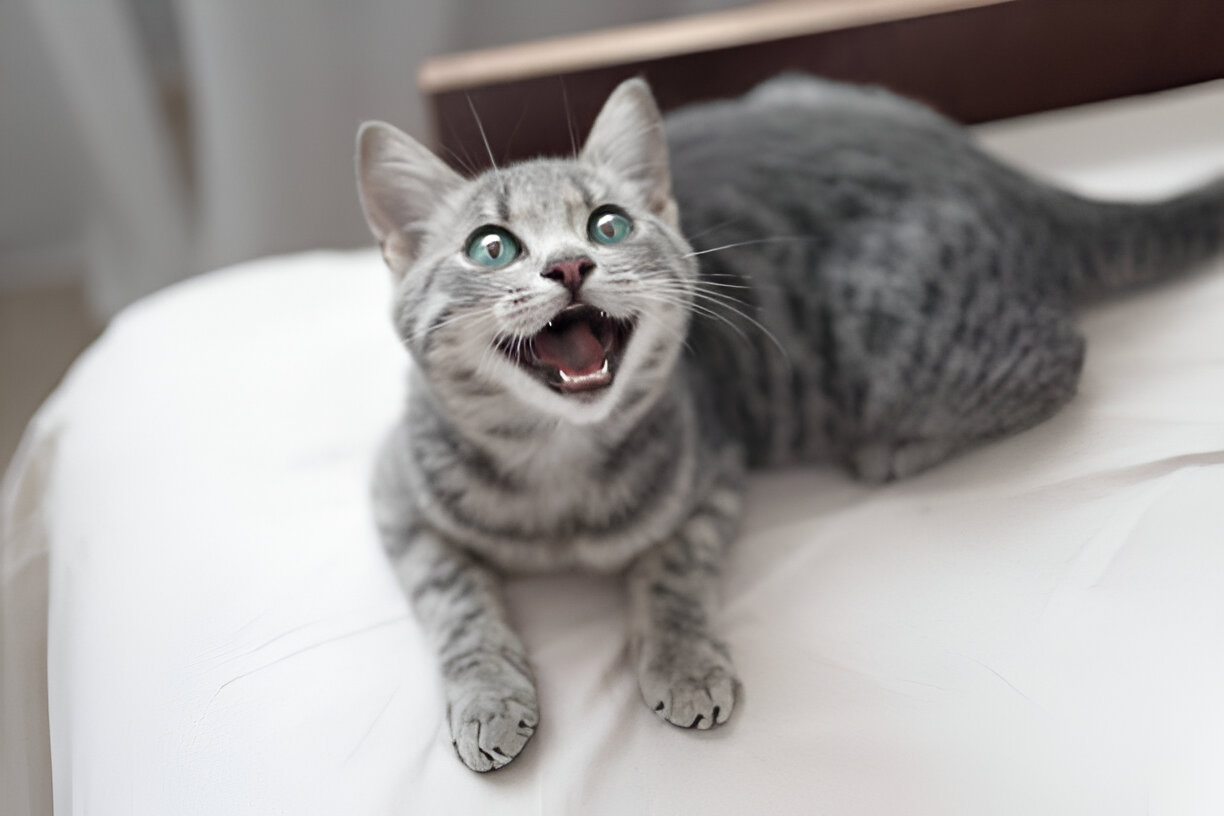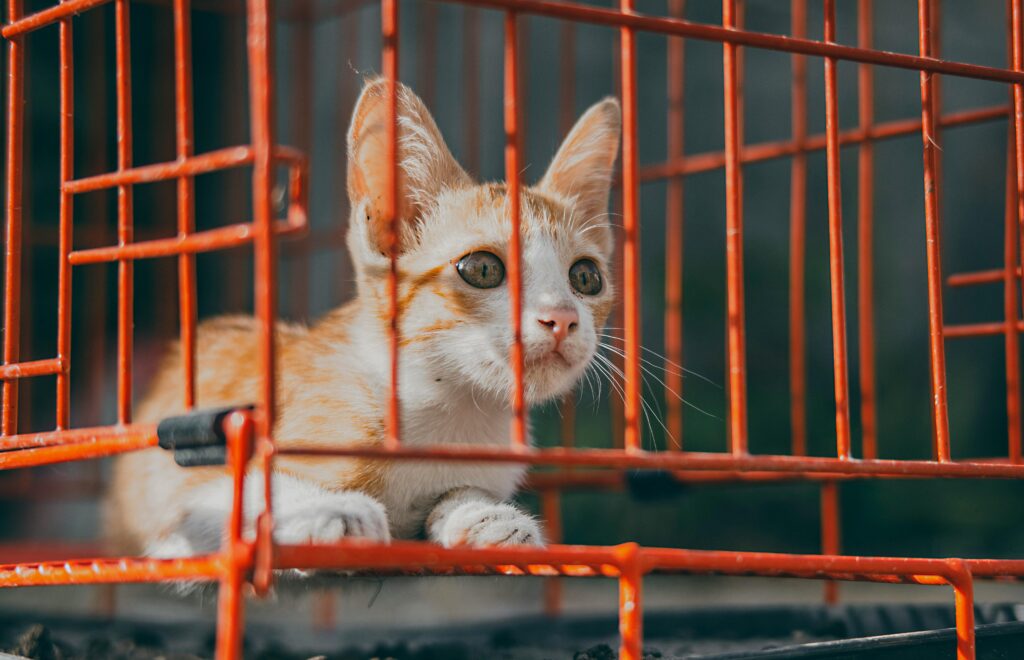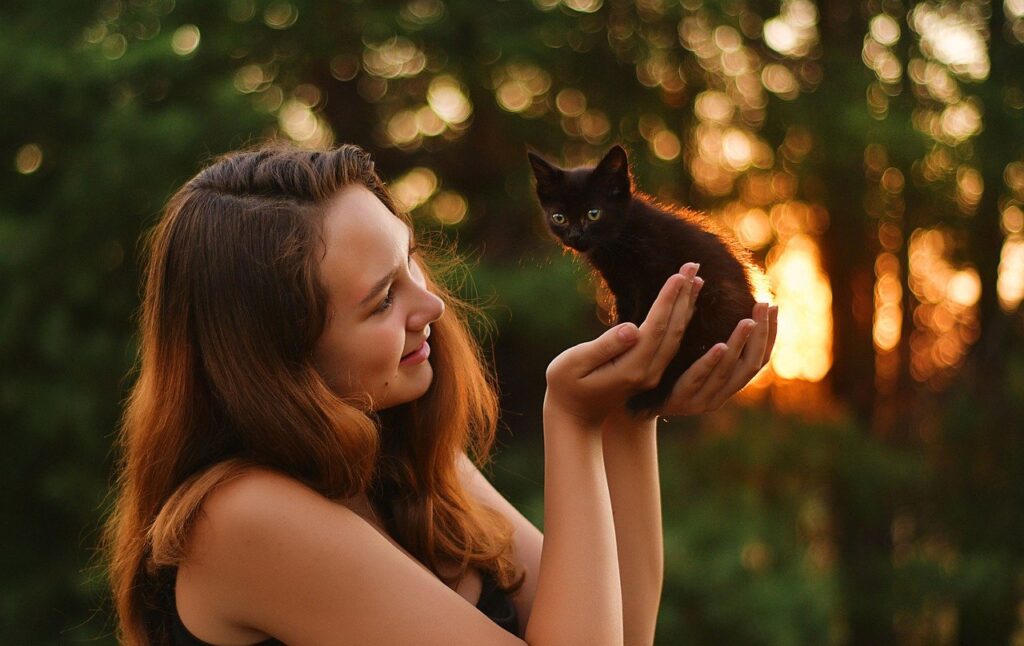<10 Essential Things Your Cat Needs for a Happy>
Introduction:
Understanding Your Cat’s Basic Needs
Cats are beloved companions that bring joy, comfort, and entertainment to our lives. However, to ensure your feline friend lives a happy and healthy life, it’s essential to meet their basic needs. From proper nutrition to mental stimulation, this guide will walk you through the 10 essential things your cat needs to thrive. Whether you’re a new cat owner or a seasoned pet parent, this checklist will help you provide the best care for your furry friend.
1. A Nutritious Diet: Selecting the Right Food for Your Feline Friend
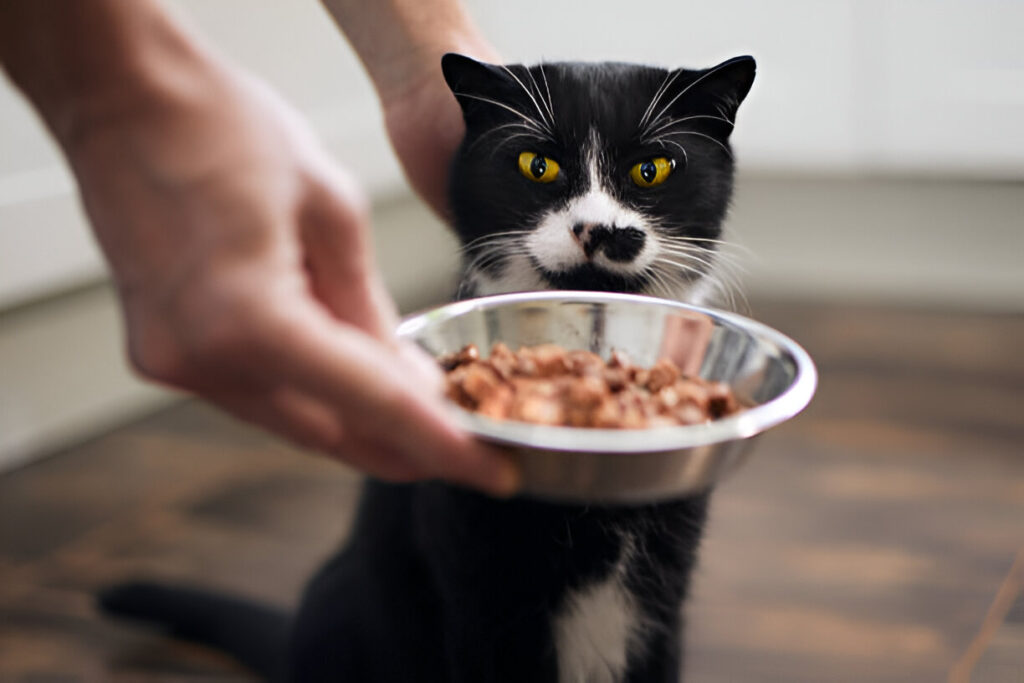
Cats are singular creatures, and their needs in nutrition differ from many other pets. Being obligate carnivores, their bodies are designed to thrive on a diet rich in animal protein. One of the most important ways to ensure health, longevity, and happiness for your cat is through proper nutrition. Here is an expanded guide to help you choose the best food for your feline friend.
Why a Nutritious Diet Matters
A good diet is a cornerstone for your cat’s overall health. It supports both:
- Energy Levels: Your cat is naturally an active animal that requires superior protein to energize all of its daily activities.
- Immune System: All sorts of necessary nutrients, such as vitamins, minerals, and amino acids (like taurine), help your cat maintain a strong immune system.
- Coat and Skin Health: A proper diet means shining coat and healthy skin.
- Digestive Health: Proper food helps in digestion without giving way to hairballs and gastrointestinal problems.
- Longevity: A nutritious diet can avoid obesity, diabetes, and other health complications, thus helping your cat to live a healthier and longer life.
Essential Ingredients in Feline Food
1. High-Quality Animal Protein
Cats are animals that require high-quality, animal-based protein to survive. Look for foods that contain a named first ingredient of meat, for example:
- Chicken
- Turkey
- Beef
- Fish-such as salmon and tuna
Avoid foods with terms like “meat by-products” or “animal meal,” since these tend to be much lower quality.
2. Healthy Fats
Fats provide energy and help with skin and coat health. Look for foods containing:
- Omega-3 fatty acids from fish oil
- Omega-6 fatty acids from poultry fat
3. Essential Vitamins and Minerals
Cats have very specific nutrient requirements, including the following:
- Taurine: An amino acid important for heart and eye health.
- Vitamin A: Important for vision and immune function.
- Calcium and Phosphorus: For strong bones and teeth.
4. Moisture Content
- Cats have low thirst drive and seldom drink sufficient water. Wet food aids in hydration and will lessen the chances of urinary tract issues.
Wet Food vs. Dry Food: Pros and Cons
Wet Food
Pros:
- High moisture content helps with hydration.
- Often more palatable for picky eaters.
- Lower in carbohydrates, which is better for weight management.
Cons:
- More expensive than dry food.
- Requires refrigeration after opening.
- Shorter shelf life.
Dry Food
Pros:
- Convenient for free-feeding.
- Longer shelf life and no refrigeration needed.
- Can help maintain dental health by reducing plaque buildup.
Cons:
- Lower moisture content, which may lead to dehydration.
- Often higher in carbohydrates, which can contribute to obesity.
Pro Tip: A combination of wet and dry food can provide the benefits of both while addressing your cat’s preferences and nutritional needs.
How to Choose the Right Cat Food
1. Check the Label
- Look for foods that meet the standards of AAFCO (Association of American Feed Control Officials). This will ensure the food is complete and nutritionally balanced.
- Avoid foods with a lot of fillers, such as corn, wheat, or soy, which have little nutritional value.
- Avoid artificial additives, colors, and preservatives.
2. Consider Your Cat’s Life Stage
- Kittens: High-calorie, protein-rich food to help them grow. Adults: A balanced diet to keep them healthy and full of energy. Seniors: Lower-calorie food can be helpful, and adding nutrients that support joint health, such as glucosamine.
3. Address Special Dietary Needs
Weight Management: A low-calorie, high-protein formula for overweight cats. Food Allergies: Limited ingredient or hypoallergenic diets are good.
- Health Conditions: Cats with kidney disease, diabetes, or other issues may need prescription diets.
Feeding Tips for a Healthy Cat
- Portion Control: Overfeeding can lead to obesity, so follow the feeding guidelines on the food packaging or your vet’s recommendations.
- Scheduled Meals: Feed your cat at the same times each day to establish a routine.
Human Food No-No Food similar to chocolate, onions, and garlic is toxic to cats. Give the cat-specific snacks. • Freshness Counts: Store dry food in an airtight container, and wet food should be refrigerated after opening.
Pro Tip: Check with Your Veterinarian
Just like people, every cat is different, and their nutritional needs can vary depending on age, weight, activity level, and health conditions. Your veterinarian can help you:
- Determine the correct type and quantity of food your cat needs.
- Manage specific health issues with diet.
- Keep track of your cat’s weight and overall health over time.
Signs of a Healthy Diet
When your cat is on the right food, you will notice:
- A shiny, soft coat.
- Consistent energy levels.
- Healthy weight-neither too thin nor overweight.
- Regular bowel movements.
- Bright eyes and clean ears.
If you notice changes in appetite, weight, or behavior, consult your vet to rule out underlying health issues.
2. Clean Fresh Water: Ensuring Proper Hydration for Your Cat
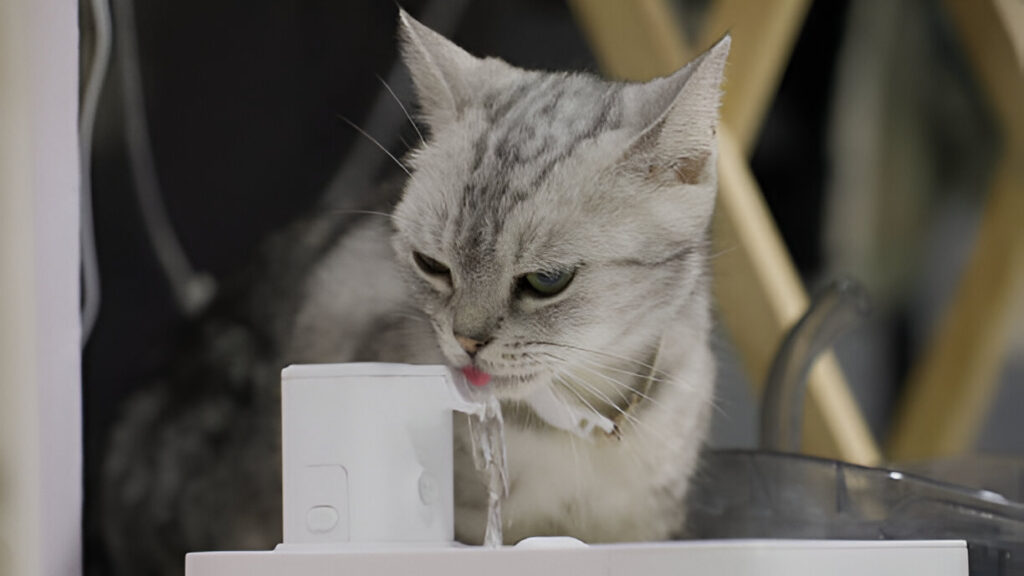
Hydration is as crucial as nutrition when it comes to your cat’s health. Cats, by nature, tend to become dehydrated easily, which may further lead to serious problems such as urinary tract infections, kidney diseases, and other health disorders. It is very necessary to ensure that your cat always has access to clean and fresh water. Here’s how to keep your feline friend well-hydrated and healthy.
Why Hydration Matters
Low urine excretion in the cat is tied back through natural instinct with their desert-origin ancestors, where most of the moisture came in through prey. This is commonly the case wherein many cats, even when fed foods having a low-moisture content, inadequately receive enough water simply by drinking alone. The outcome of dehydration:
- Urinary Tract Issues: Concentrated urine can lead to crystals or blockages.
- Kidney Problems: Long-term dehydration puts a lot of pressure on the kidneys, which filter toxins.
- Lethargy and Poor Appetite: Dehydrated cats may become lethargic and lose their appetite.
How to Encourage Your Cat to Drink More Water
1. Provide Fresh Water Daily
- Change the water in your cat’s bowl at least once a day to keep it clean and appealing.
- Use a shallow, wide bowl to avoid whisker fatigue, which can make cats not want to drink.
2. Use a Cat Water Fountain
- Many cats like running water since it is fresher and more natural for them.
- Water fountains provide a continuous flow of filtered water, which encourages your cat to drink more.
3. Place Water Bowls Strategically
- Keep water bowls away from food and litter boxes; cats like their water source to be separate.
- Place additional water stations around your home to make hydration convenient for them.
4. Add Wet Food to Their Diet
- Wet foods contain as much as 80% moisture, which counts a great deal in your cat’s hydration.
- Add a little wet food to your cat’s diet if they are dominantly on dry food.
5. Experiment with Water Temperature
Some cats like cold water, others at room temperature. Try each to determine your cat’s preference.
Dehydration Signs to Watch For in Cats
Watch for these signs that may show your cat is not getting enough water:
- Dry Gums: Lightly lift your cat’s lip; the gums should feel moist.
- Lethargy: A dehydrated cat may be more tired or less active than usual.
- Loss of Skin Elasticity: Gently pinch the skin on the back of your cat’s neck. If it doesn’t snap back quickly, they may be dehydrated.
- Sunken Eyes: The eyes may appear dull or sunken. If you notice any of these signs, contact your veterinarian immediately.
Pro Tip: Monitor Water Intake
Keep an eye on how much your cat drinks, especially if they eat mostly dry food. A healthy cat typically drinks about 3.5–4.5 ounces of water per 5 pounds of body weight daily. If you’re unsure, consult your vet for guidance.
3. Litter Box Essentials: Choosing the Right Litter and Location
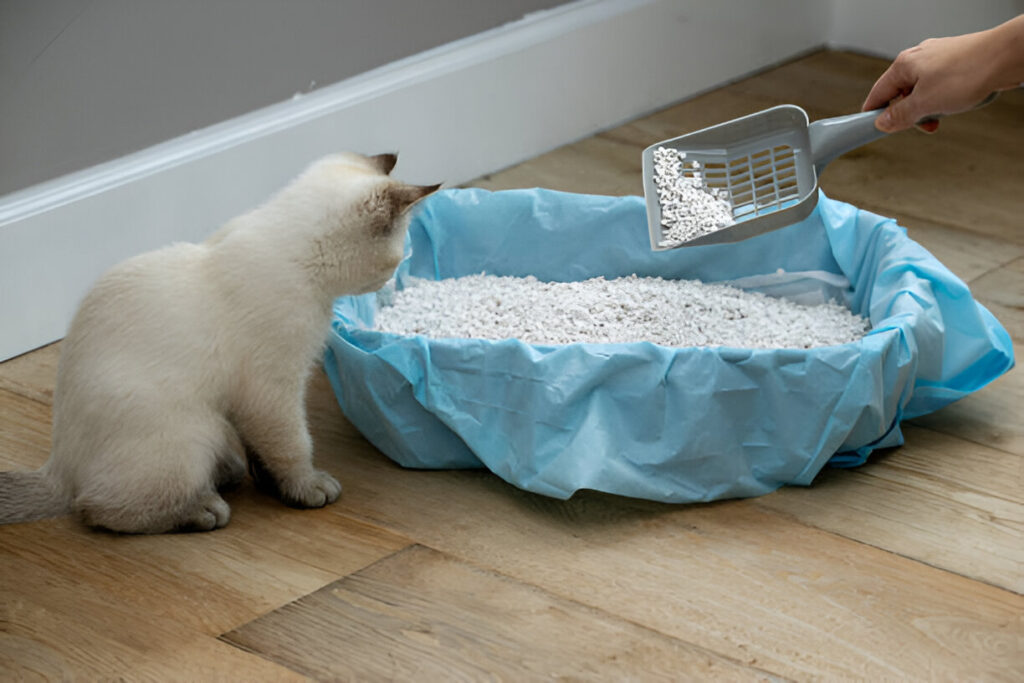
A clean litter box is of essence in comfort and hygiene for your cat. Cats are essentially clean animals, and giving them an appropriate litter box setup will help prevent accidents and stress. Here is a detailed guide to choosing the right litter and location, with additional tips on keeping the box clean and inviting.
Why the Litter Box Matters
The litter box is more than a convenience; it’s an integral part of your cat’s daily life. A poorly maintained or poorly placed litter box can lead to the following:
- Stress and Anxiety: Cats may avoid using a dirty or inconveniently placed box.
- Health Issues: Holding in waste can cause urinary or digestive problems.
- Behavioral Issues: Cats will begin to eliminate outside the box if they are displeased with its condition.
How to Choose the Purr-fect Litter Box
Size Matters
- The litter box should be large enough for your cat to turn around and dig comfortably.
- For larger cats, consider an extra-large box or a storage bin with low sides.
Type of Box
- Open Boxes: Easy to access and clean, but may not retain odors as well.
- Covered Boxes: Allow for privacy and reduce litter scatter, but some cats may not like confinement.
- Self-Cleaning Boxes: Automatically scoop the waste but are noisy and expensive.
Choosing the Correct Litter
Cats can be quite finicky about litter, so finding one they like is important. Some of the common varieties include:
Clumping Litter
- Has the ability to solidify when wet into well-formed clumps, thereby allowing for easy scooping.
- Made from clay or plant-based materials.
Non-Clumping Litter
- Absorbs moisture but does not form clumps.
- Needs changes more frequently.
Natural Litter
- Made from materials like pine, corn, wheat, or recycled paper.
- Environmentally friendly and generally dust-free, though not as effective with odor control.
Silica Gel Litter
- Highly absorbent and excellent for odor control.
- Lightweight but can be more expensive.
Pro Tip: Give a little of the new litter a try to see how your cat reacts before buying that huge sack.
How to Choose the Ideal Place
Quiet and Secluded
Place the litter box in an area that has minimum traffic so your cat is left alone. Avoid placing the litter box near noisy appliances, like washing machines, or where there are loud noises. Always Accessible
- The box should be accessible to your cat at all times, particularly for young, aged, or felines with some kind of disability in movement or locomotion.
- Avoid placing the box in inaccessible locations like the basement or closets.
Not Near Food and Water
- Cats are fastidious animals that prefer to eat in a spot far away from where they excrete.
- Place the litter box in another room from where they eat and drink.
Keeping the Litter Box Clean
Scoop Daily
- At the very minimum, clean the waste out of the box once a day so it can stay fresh.
- Use a heavy-duty scoop for a quick and easy clean.
Clean Weekly
- Change the litter completely and clean the litter box with mild soap and water.
- Avoid using strong chemicals, as this could make your cat avoid the box altogether.
Replace Litter Regularly
- Even with daily scooping, litter should be replaced entirely every 1–2 weeks.
Line the bottom of the box with a thin layer of baking soda for odor control.
Pro Tip: The “N+1” Rule
For multi-cat households, follow the “one litter box per cat plus one” rule. Example:
- 1 Cat: 2 litter boxes
- 2 Cats: 3 litter boxes
- 3 Cats: 4 litter boxes
This would decrease competition at the box and ensure that all cats get a chance to go in a clean box.
Signs of Litter Box Problems
If your cat begins to avoid the litter box, it may indicate the following:
- Health Issues: Urinary tract infections, kidney problems, or arthritis.
- Stress: Changes in the household, new pets, or a dirty litter box.
Litter preferences- disliking the litter type or a location where the box is placed.
When your cat persists, seek help from your veterinarian to eliminate the medical reasons for his bad behavior.
4. A Comfortable Sleeping Area: Creating a Cozy Space for Rest and Relaxation
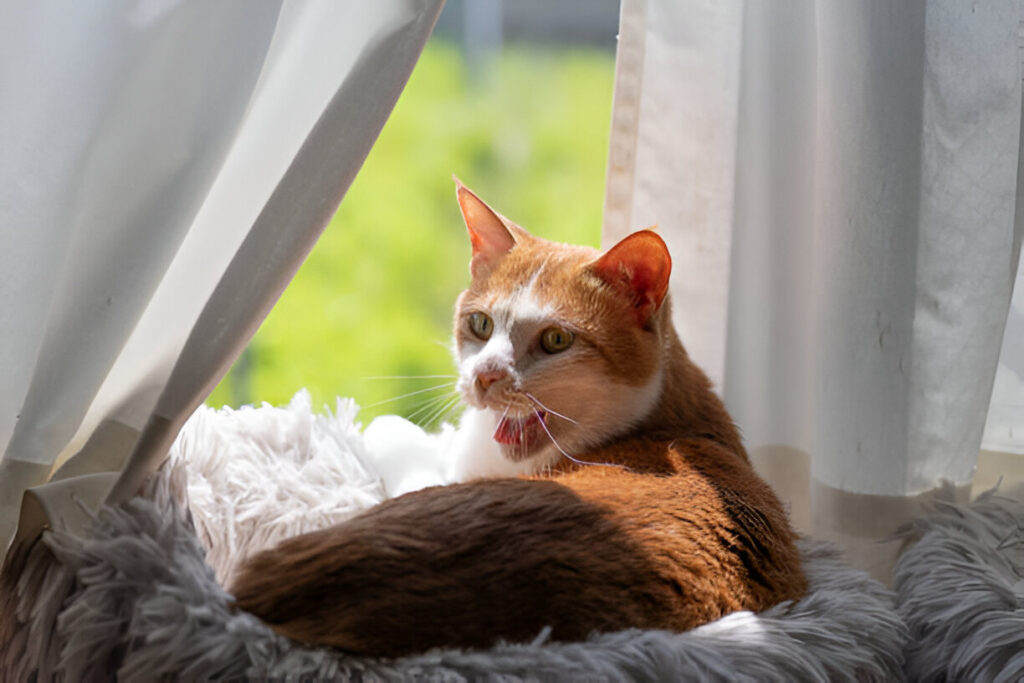
Cats are champions of napping, with the average amount of time spent sleeping being 12–16 hours a day. Giving them a comfortable and inviting sleeping space is quite important. Not only will a cozy sleeping place guarantee your cat the rest they need, but it also offers them security and comfort. Here’s how to create the perfect sleeping space for your feline friend.
Why a Comfortable Sleeping Area Matters
- Supports Health: Quality sleep helps your cat recharge, maintain energy levels, and support their immune system.
- Reduces Stress: A safe, quiet space allows your cat to relax and feel secure.
- Promotes Natural Behavior: Cats instinctively seek out warm, cozy spots to rest, mimicking their wild ancestors’ habits.
How to Create the Perfect Sleeping Spot
Bed Selection
- Soft and Warm: Find a plush bed or blanket of fleece or faux fur.
- Size Counts: Make sure the bed is large enough to allow your cat to stretch out in comfort.
- Shape Options: Some cats like to sleep in enclosed beds, such as caves or igloos, while others prefer to sleep on open, flat surfaces.
Choose a Quiet Location
Place the bed in an area where your cat won’t be disturbed. Avoid placing the bed near noisy appliances or areas of the house that receive a lot of traffic.
Elevated Spaces
Cats enjoy elevated spaces where they can survey their surroundings. Consider:
- Cat Trees: Multilevel structures with integrated beds.
- Window Perches: Allow your cat to bask in the sun and watch the world outside.
- Shelves or Wall-Mounted Beds: Great for saving space and giving your cat a cozy vantage point.
Warmth and Comfort
Add a soft blanket or cushion to make it even more inviting.
Heated bed or a warm spot next to a radiator in colder months-just make sure it is safe and not too hot.
How to Encourage Your Cat to Sleep in Their Bed
Place familiar scents: add a blanket or toy that holds your or cat’s scent to the bed for a welcoming scent. Smell is comforting. Rewarding positive behaviors: give treats and praise for actually using their bed. Rotate sleeping spots: once in a while, exchange the bed for another sleeping place. This will give novelty.
Pro Tip: Observe Your Cat’s Preferences
Every cat is unique, so pay attention to where they naturally like to sleep. Do they prefer:
- Sunny Spots? Place their bed near a window.
- Hidden Areas? Opt for an enclosed bed or a quiet corner.
- High Perches? Invest in a cat tree or shelf.
By tailoring the sleeping area to your cat’s preferences, you’ll create a space they’ll love.
Signs Your Cat Loves Their Sleeping Area
They regularly sleep in their bed or favored sleeping place.
They are visibly relaxed and comfortable sleeping.
They groom themselves or play with the bed before retiring.
If your cat avoids the bed, try re-locating it, changing its type, or making it more/less comfortable.
5. Toys and Enrichment Activities: Keeping Your Cat Entertained and Mentally Stimulated
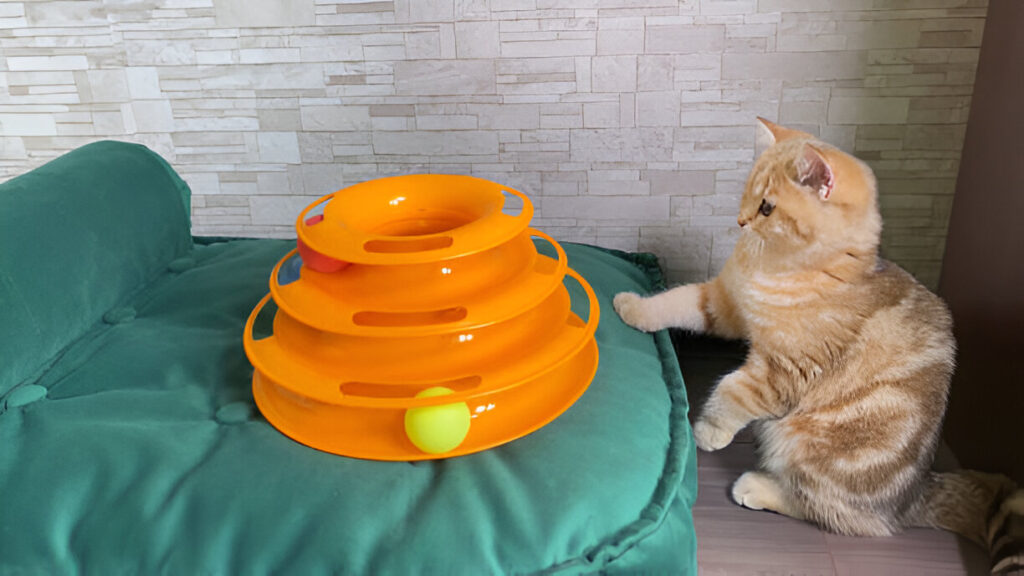
Cats are natural predators and curious animals. Without adequate mental and physical stimulation, they can become bored, stressed, or even destructive. Providing toys and enrichment activities is crucial for maintaining your cat’s happiness, health, and engagement. Here’s how to create an enriching environment that caters to your cat’s instincts and needs.
Why Enrichment Matters
Prevents Boredom: A bored cat will always have a tendency to ruin furniture by scratching or over-groom.
Supports Physical Health: It will keep your cat active, and it will maintain a good weight and develop better coordination.
Boosts Mental Health: It keeps the mental stimulation at a higher level to reduce stress and anxiety in your cat.
Strengthens Your Bond: Interactive playing builds trust and deepens your relationship with your cat.
Types of Toys and Activities
1. Interactive Toys
- Feather Wands: Mimic the movement of birds, encouraging your cat to jump and pounce.
- Laser Pointers: Great for chasing, but always follow up with a physical toy to “catch” to avoid frustration.
- Motorized Toys: Move on their own, keeping your cat entertained even when you’re not around.
2. Puzzle Feeders
- These are toys designed to dole out treats or kibble upon interaction with it, thereby integrating play and mealtimes together.
- Examples of these are treat balls, maze feeders, or even interactive mats.
3. Prey-Like Toys
- Toys that resemble little mice, birds, or insects will have your pet practicing their hunting skills all on their own.
- Purchase them sprinkled with catnip or made from a crinkly material for added delight.
4. Homemade Toys
- Items in your house, such as balled-up paper, boxes, or empty tubes from toilet paper, can keep your cat busy for hours.
- Put some boxes or covers over them and make a “fort” for the cat to play in.
Tips to Keep Your Cat Busy
1. Rotate Toys Frequently
- Cats get bored with toys if they are always available. Rotate them every few days to keep things fresh and exciting.
2. Daily Play Sessions
- Devote 10–15 minutes a day to interactive play with your cat, using toys that encourage chasing, pouncing, and stalking.
3. Create a Stimulating Environment
Set up climbing shelves, cat trees, or window perches to let your cat look around and observe. • Place bird feeders outside windows to provide “cat TV.”
4. Use Catnip or Silvervine
- Sprinkle catnip on toys or scratchers to make them more alluring. • Silvervine is another herb most cats cannot get enough of.
Pro Tip: Mimic Prey Behavior
While playing with your cat, make the movements of prey to involve them in hunting. For example:
Move a feather wand as if it were a fluttering bird.
Drag a toy mouse across the floor to simulate scurrying.
Allow your cat to “catch” the toy occasionally to satisfy their predatory drive.
Signs Your Cat is Having a Good Time in Play
- They attack, pursue, or bat at toys with energy.
- Their tail twitches or their ears perk up during play.
- They purr or meow during contact with you or the toy.
If your cat seems not to care, change the toys or activity and find out what they like most.
6. Sufficient Scratching Posts: Protecting Furniture While Promoting Natural Behavior
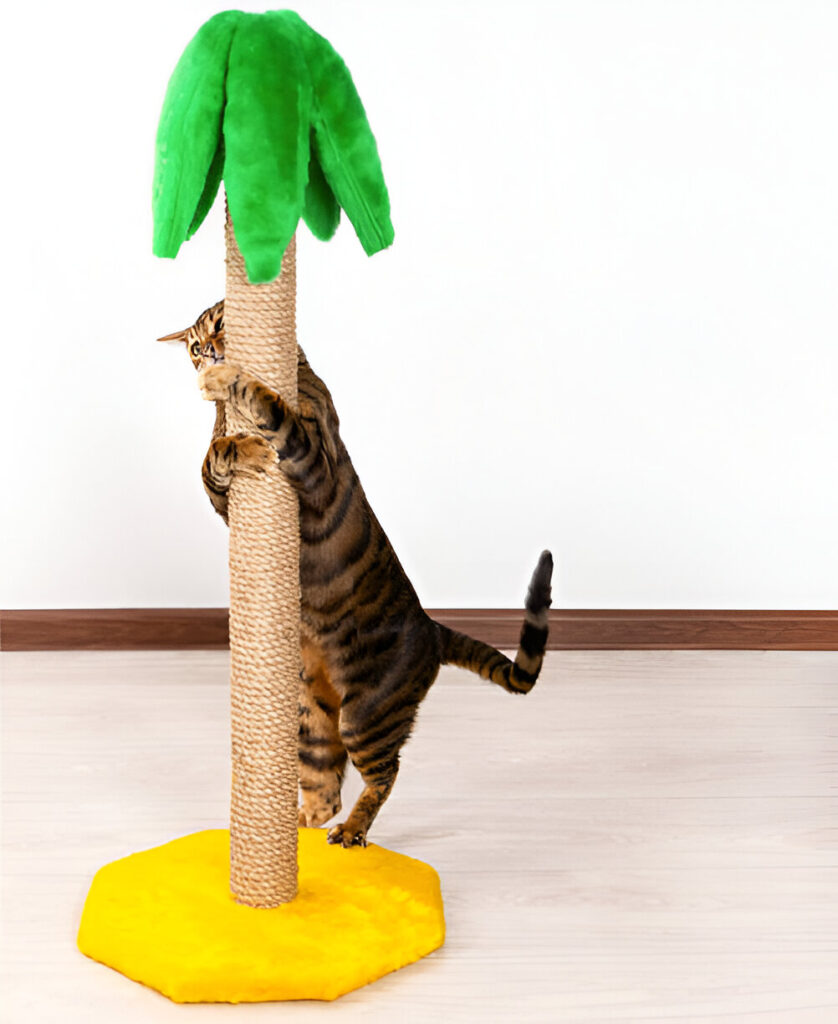
Scratching is a natural behavior for cats, which stretches, marks territory, and keeps their claws healthy. It’s natural and necessary, but when your cat chooses your furniture to scratch, well, it’s just plain frustrating. The key to redirecting this behavior while keeping your cat happy and healthy is to provide enough scratching posts and pads. Here’s how to do it effectively.
Why Scratching is Important
- Stretching: Scratching helps cats stretch these muscles, especially after waking up.
- Claw Maintenance: It removes the outer layer of their claws, thus maintaining their sharpness and health.
- Territory Marking: Cats have scent glands in their paws, so scratching leaves both a visual mark and a scent.
- Stress Relief: Scratching can be a way for cats to release pent-up energy or frustration.
Choosing the Right Scratching Posts and Pads
1. Material Matters
Cats do have their preference for scratching surfaces. Common options are:
- Sisal: Durable, rough, and a favorite for most cats.
- Cardboard: Inexpensive and perfect for horizontal scratching.
- Carpet: Soft and inviting, but make sure it is different from your carpet.
- Wood: Some cats prefer to scratch on wood.
2. Types of Scratchers
- Vertical Posts: For those cats that like to stretch upward.
- Horizontal Pads: For those cats that prefer scratching on flat surfaces.
- Angled Scratchers: Combine the benefits of vertical and horizontal options.
- Multi-Level Scratchers: Often part of cat trees, providing scratching and climbing opportunities.
3. Size and Stability
- Provide a cat scratching post tall enough to enable your cat to stretch fully.
- Make sure it is sturdy enough not to fall over when leaned against.
How to Encourage Your Cat to Use Scratching Posts
1. Placement is Key
- Place scratching posts near where your cat spends most of their time, such as near their sleeping area or by a window.
- Set them near furniture that your cat tends to scratch in order to redirect their behavior to the scratching post.
2. Make It Appealing
- Sprinkle catnip on the scratcher to attract your cat.
- Lure them to the post with toys or treats to entice and reward them for using it.
3. Positive Reinforcement
- Praise your cat and give them treats when they use the scratching post.
- Never punish them for scratching furniture because this will only create stress and confusion.
4. Multiple Options
Also, provide several scratching posts and pads in various places and of different materials for your cat to choose their preference.
Pro Tip: Redirect, Don’t Punish
If your cat starts scratching furniture, gently direct it toward a scratching post. Lure them towards the post, using toys or treats, then reward upon use. Above all, consistency and patience play major roles.
Signs Your Cat Loves Their Scratching Post
They frequently use the post or pad.
They stretch and scratch with vigor.
They knead or rub against the post to leave their scent on it.
If your cat avoids the scratcher, try changing materials, locations, or type of post.
7. Regular Veterinary Check-ups: Monitoring Health and Preventive Care
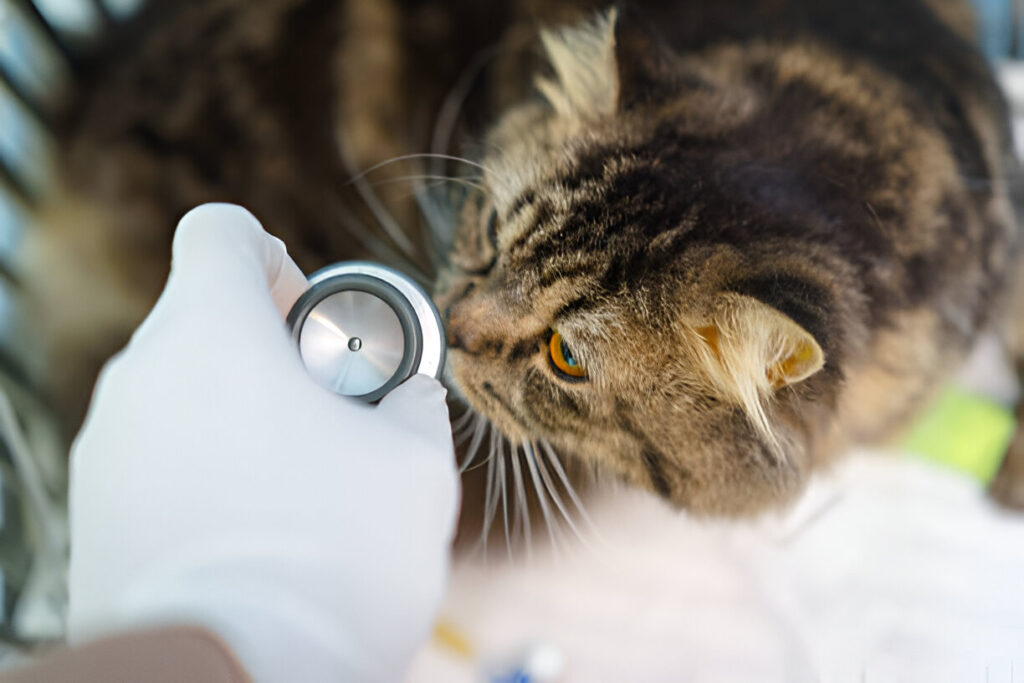
Regular veterinary check-ups help in maintaining health and diagnosing early signs of ailments. Cats are masters at masking illness, and regular visits to the vet are often preventive measures or means of catching it early. Here’s a detailed look at why vet visits are important and how to maximize your time with your cat.
Early Detection: Cats mask their illness until it is quite advanced. Regular check-ups can catch problems early.
Preventive Care: Vaccinations, parasite control, and dental care prevent many health issues.
Longevity: Routine care extends your cat’s life by taking care of health concerns before they are serious.
Peace of Mind: Knowing your cat is healthy enhances your bond and lessens stress.
What to Expect When Going to a Veterinarian’s Office
- Physical Exam
Weight, coat, eyes, ears, teeth, and body condition: your cat receives an exam from the vet.
They will then auscultate over the heart and lungs and abodominal palpate to check for some sort of pathology. - Vaccinations
All cats will receive core vaccinations; these are:
Rabies vaccination
Feline distemper.
- Non-core vaccines include feline leukemia and are dependent upon your cat’s lifestyle.
3. Parasite Prevention
- Discussion on flea, tick, and worm treatment and recommendations on their need
- Deworming on a regular basis with prevention medication is necessary even for indoor cats.
4. Dental Check
- Dental health is very important for general health. The veterinarian will be checking the state of gums, teeth, and other oral cavities for disease, decay, or infection.
- Professional cleanings may be advised in certain cases where this is deemed necessary.
5. Bloodwork and Tests
- For a senior cat or one that is sickly, blood tests, urinalyses, or other diagnostic tests may be suggested.
How Often Should Your Cat Go to the Vet?
- Kittens: Every 3–4 weeks until they’re 16 weeks old for vaccinations and growth monitoring.
- Adult Cats: At least once a year for routine check-ups and vaccinations.
- Senior Cats (7+ years): Twice a year, as older cats are more prone to health issues.
Signs Your Cat Needs Immediate Veterinary Attention
While routine check-ups are crucial, some symptoms make a case for seeking urgent attention. Contact your vet if:
- Changes in Appetite: Much more or less eating and drinking than normal.
- Lethargy: Unusual depression or unusual lack of energy.
- Vomiting or Diarrhea: Prolonged or severe.
- Behavioral Changes: More aggression, hiding, or vocalization.
- Litter Box Problems: Straining to urinate, blood in urine, or avoiding the litter box. • Weight Loss or Gain: Sudden changes without an apparent reason.
Pro Tip: Keep a Health Journal
Keep a record of your cat’s:
- Vaccination history.
- Medication and treatments.
- Weight changes.
- Behavioral or physical symptoms.
This helps your veterinarian to identify trends and make relevant decisions concerning your cat’s care.
Preventive Care Tips
1. Spaying/Neutering
- Prevents undesired litters and decreases the risk of specific cancers and behavior problems.
2. Dental Care
- Regularly brush your cat’s teeth using a toothpaste suitable for them.
- Give them some dental treats or toys to minimize plaque formation.
3. Parasite Control
- Use vet-recommended flea, tick, and worm treatments throughout the year.
- Check your cat’s coat regularly for signs of parasites.
4. Senior Cat Care
- Watch for age-related problems such as arthritis, kidney disease, or diabetes.
- Change their diet and activity level accordingly.
8. Grooming Supplies: Maintaining Coat Health with Regular Grooming Sessions
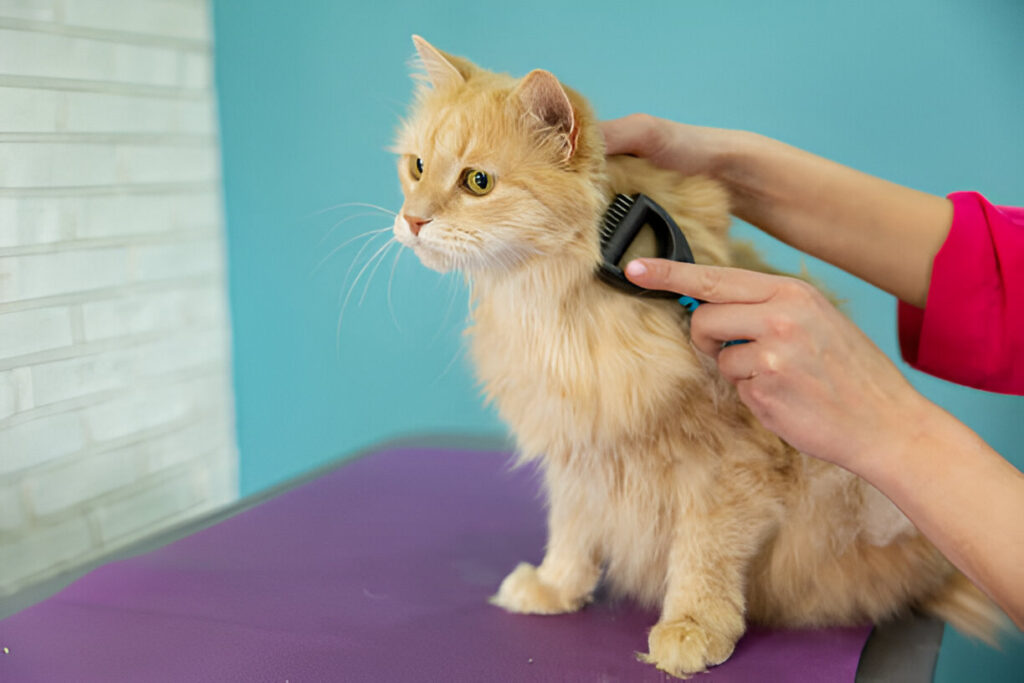
Key Points:
- Regular grooming helps prevent matting, hairballs, and skin issues.
- Brush your cat’s coat weekly (or daily for long-haired breeds) using a suitable brush or comb.
- Trim nails every 2–3 weeks to prevent overgrowth and scratching damage.
- Clean ears and teeth as part of your grooming routine.
Pro Tip: Introduce grooming gradually and reward your cat with treats to create a positive experience.
9. Identification Tags or Microchips: Ensuring Safety with Proper Identification
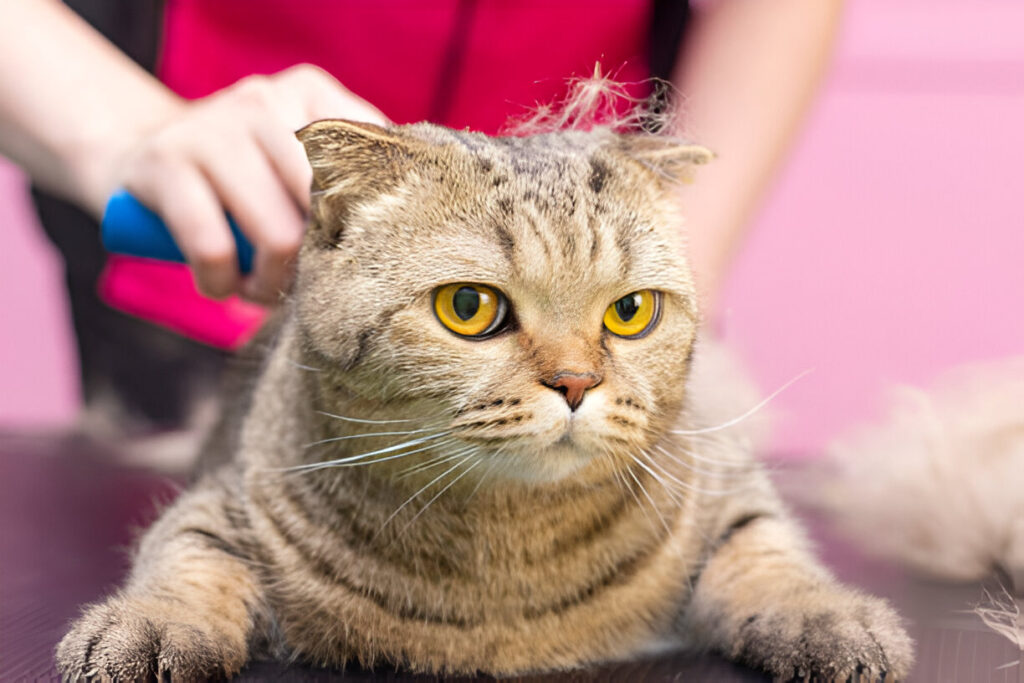
Being natural curiosity seekers, even the most cautious indoor cat can get themselves lost or slipped outdoors quite by accident. Accurate identification is an important aspect to ensure the safety of your cat and help the chances of reunion if your pet runs away. This article gives the real guidance on choosing correctly your identification method and keeping the cat safe.
Why Identification is Important
Fast Recovery: An identified stray cat is much more likely to be returned to you sooner.
Psychological Balance: Knowing that your cat has an identification will reduce stress and anxiety.
Safety: Microchip and identification tags aid shelters or vets to contact you if the cat is found in injury or disease condition.
Types of Identification
1. Collars and ID Tags
- What to Include: Your cat’s name, your phone number, and optionally, your address.
- Breakaway Collars: Designed to release if it gets caught on something to prevent choking or injury.
- Reflective or Glow-in-the-Dark Tags: Help make your cat visible at night.
2. Microchips
- What It Is: A microchip about the size of a grain of rice installed under your cat’s skin-usually between the shoulder blades.
- How It Works: The chip bears a unique identity number tied back to a database with your information on it.
- Permanent Solution: Unlike the potential to lose your cat’s collars, it just simply will not come or get torn off.
3. GPS Trackers
- What It Is: A small device attached to your cat’s collar that pinpoints their whereabouts in real-time.
- Best For: Outdoor cats or cats who often get lost.
How to Properly Identify
1. Pick the Right Collar and Tag
- Ensure the collar is suitably small but comfortable-you should be able to fit two fingers underneath.
- Check regularly that the tag is secure and readable.
2. Microchip Your Cat
- Have it implanted by a veterinarian or trained professional.
- Register the chip with your contact information in a national database.
3. Keep Information Updated
- If you move or change your phone number, update your information in the database for the microchip and also on the identification tag.
- Check with the vet over time to confirm the chip is continuing to function effectively.
4. Combine Methods
- Employ both identification methods of a collar carrying an ID tag and a microchip for ultimate safety.
GPS trackers can be an added layer of security for adventurous cats.
Pro Tip: Test the Microchip
Ask your vet to scan the microchip during check-ups to make sure it’s working and the information is current.
What to Do If Your Cat Goes Missing
- Search Immediately: Check your home, yard, and neighborhood thoroughly.
- Inform the Neighbors: Tell them your cat is missing and describe your cat.
- Call Shelters and Vets: Provide them with the number of your cat’s identification and the most recent photo.
- Utilize Social Media: Post on local lost-and-found pet groups or community pages.
- Check the Microchip Database: Make sure your contact information is current to be contacted in the event of your cat showing up.
10. Love and Attention: Building a Strong Bond with Your Cat
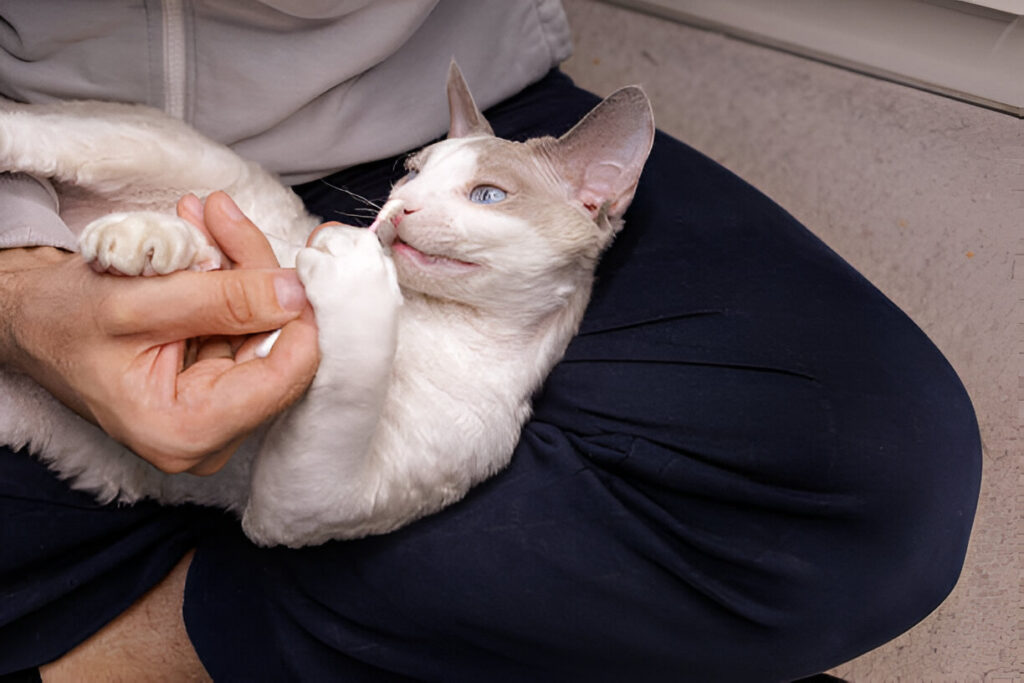
Cats have a reputation for being independent, but they are deeply social creatures that thrive on love, attention, and a sense of security. Building a strong bond with your cat not only improves their well-being but also strengthens your relationship. Here’s how to show your cat love and create a lasting connection.
Why Love and Attention Matter
- Emotional Well-being: Affection and interaction reduce stress and anxiety in cats.
- Trust and Security: Spending quality time together helps your cat feel safe and loved.
- Behavioral Health: A happy, well-loved cat is less likely to develop behavioral issues like aggression or destructive habits.
- Stronger Bond: Regular interaction deepens your relationship and fosters mutual trust.
How to Give Your Cat Love and Attention
1. Spend Quality Time Together
- Playtime: Engage your cat in at least one hour of daily interactive playtime using feather wands or laser pointers. These mimic hunting and will keep the mind and body active.
- Cuddles: If your cat enjoys being held, then spend some time holding him and gently petting him.
- Grooming: Brush your cat on a regular basis for health of the coat and bonding well with the cat.
2. Respect Their Boundaries
- Cats are individual animals and have different personalities. Some may be very affectionate, while others may like staying to themselves.
- Let your cat come to you for attention rather than forcing interaction.
- Observe for signs of unease, like flattened ears or a swishing tail, and allow them time alone when they require it.
3. Create a Calm Environment
- Provide a safe, quiet space where your cat can retreat when they need alone time.
- Reduce loud noises, sudden movements, or other stressors that might make your cat anxious.
- Make the environment pleasant through the use of a diffuser with pheromones or calming sprays.
4. Learn Their Language
- Observe the body and voice language to get an understanding of what exactly is needed at a particular point in time or mood.
- The purring, slow blinking, and the general relaxed look indicate a well-pleased cat.
- Hissing, growling, or concealing themselves indicate their unhappiness.
Pro Tip: Slow Blinking
Cats slow blink to show trust and affection. Set eyes with your cat and slowly blink. Your cat may just blink back to show love!
Signs Your Cat Feels Loved and Secure
They follow you around the house, seeking your company. They purr, knead, or rub against you.
- They display relaxed body language, such as lying on their back or curling up next to you.
- They greet you at the door or wake you up in the morning.
Activities to Strengthen Your Bond
1. Interactive Play
- Use toys that mimic prey, like feather wands or toy mice, to engage your cat’s hunting instincts.
- Spend 10–15 minutes daily playing.
2. Training
- Teach your cat basic tricks or commands with positive reinforcement through treats or praise.
- Training is an excellent way of having fun while providing mental stimulation for your cat.
3. Shared Rituals
- Establish rituals, like feeding or grooming, around the same time each day.
- Cats love predictability and will welcome this regularity.
4. Quiet Time Together
- Just sitting next to your cat while reading or watching TV can make them feel close to you.
Conclusion:
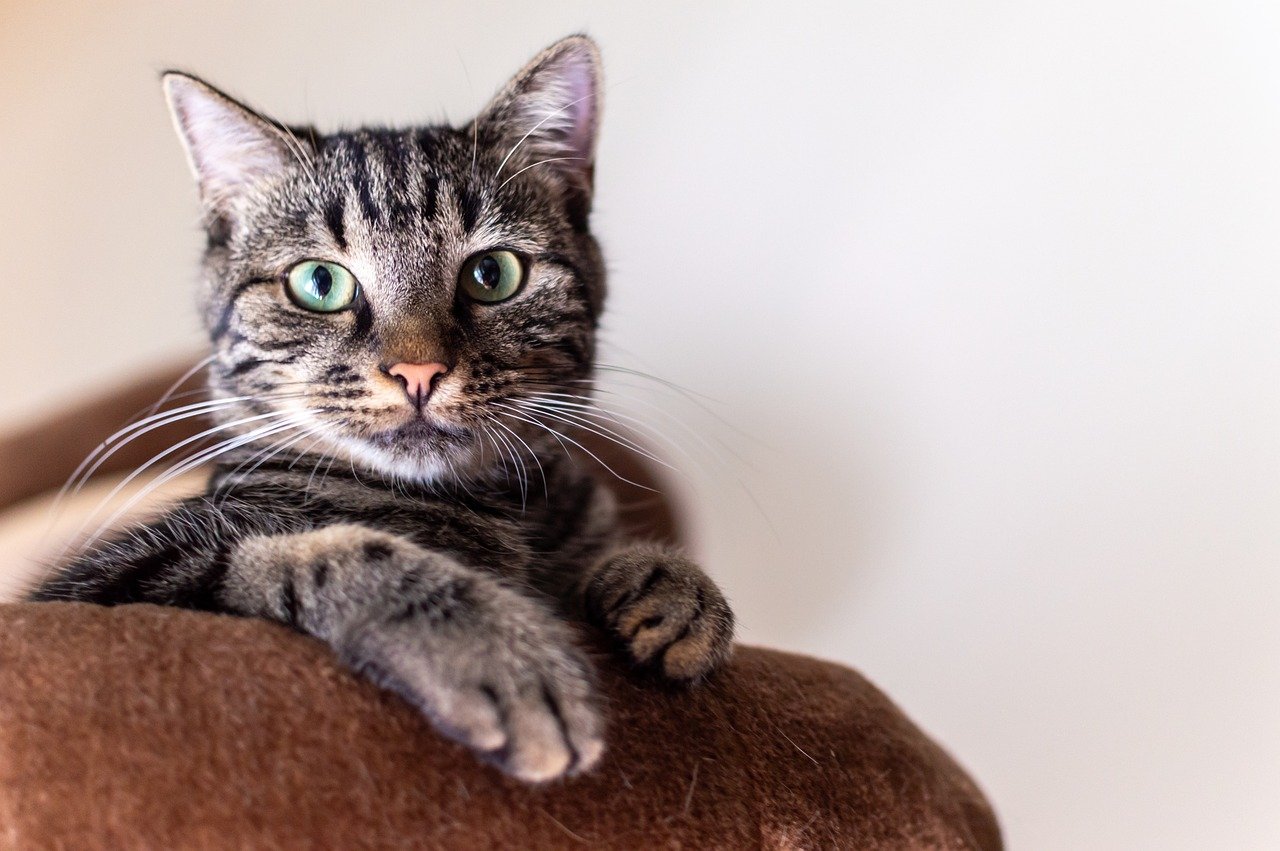
Meeting Your Cat’s Needs Leads to a Stronger Bond
Image by Jill Schafer
Providing your cat with these 10 essential things will not only ensure their physical and mental well-being but also strengthen the bond between you and your feline companion. By understanding and meeting their needs, you’ll create a happy, healthy, and fulfilling life for your cat.
Remember, every cat is unique, so tailor your care approach to suit their individual personality and preferences. With love, attention, and the right resources, your cat will thrive as a cherished member of your family.
Yuns Legdm is a passionate advocate for pet care and the founder of this website, dedicated to providing valuable information for fellow pet lovers and veterinary professionals worldwide. With a deep love for animals, Yuns created this platform to connect passionate pet owners with expert insights from veterinarians around the globe.
This website grows with you—the passionate pet owners and veterinary experts—creating a trusted space where knowledge, experience, and love for animals come together. Whether you’re seeking advice on pet health, nutrition, or general well-being, this platform is here to support you on your journey of responsible and loving pet care.

